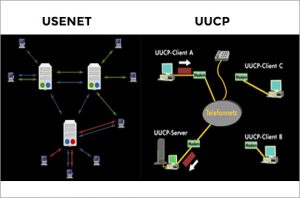UUCP and Usenet


Date: 01/01/1979
Usenet
Usenet is a worldwide distributed discussion system available on computers. It was developed from the general-purpose UUCP dial-up network architecture. Tom Truscott and Jim Ellis conceived the idea in 1979, and it was established in 1980. Users read and post messages (called articles or posts, and collectively termed news) to one or more categories, known as newsgroups. Usenet resembles a bulletin board system (BBS) in many respects and is the precursor to Internet forums that are widely used today. Usenet can be superficially regarded as a hybrid between email and web forums. Discussions are threaded, as with web forums and BBSs, though posts are stored on the server sequentially. The name comes from the term “users network”.
One notable difference between a BBS or web forum and Usenet is the absence of a central server and dedicated administrator. Usenet is distributed among a large, constantly changing conglomeration of servers that store and forward messages to one another in so-called news feeds. Individual users may read messages from and post messages to a local server operated by a commercial usenet provider, their Internet service provider, university, employer, or their own server.
UUCP
UUCP is an abbreviation of Unix-to-Unix Copy. The term generally refers to a suite of computer programs and protocols allowing remote execution of commands and transfer of files, email and netnews between computers.
A command named uucp is one of the programs in the suite; it provides a user interface for requesting file copy operations. The UUCP suite also includes uux (user interface for remote command execution), uucico (the communication program that performs the file transfers), uustat (reports statistics on recent activity), uuxqt (execute commands sent from remote machines), and uuname (reports the UUCP name of the local system). Some versions of the suite include uuencode/uudecode (convert 8-bit binary files to 7-bit text format and vice versa).
Although UUCP was originally developed on Unix in the 1970s and 1980s, and is most closely associated with Unix-like systems, UUCP implementations exist for several non-Unix-like operating systems, including Microsoft’s MS-DOS, IBM’s OS/2, Digital’s VAX/VMS, Commodore’s AmigaOS, classic Mac OS, and even CP/M.